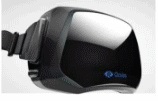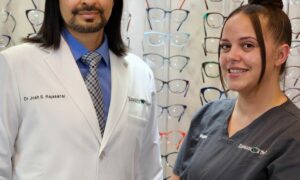“Insights to Foresights: Shaping the Future of Our Industry Together”
Highlights from a Webinar with Howard Purcell, OD, FAAO, Dipl.,

Senior Vice President of Customer Development,
Essilor of America, Inc.
Howard Purcell, OD, FAAO, Dipl., Senior Vice President, Customer Development of Essilor of America, Inc., recently hosted two webinars produced byReview of Optometric Business and titled,”Insights to Foresight: Shaping the Future of Our Industry Together.” In Part 1 of the webinar series,Dr. Purcell analyzes threetechnology advances and suggests ways in which independent ODs can embracenew technologyto build their practices through customization of services.
>>Click HERE to view “Insights to Foresight: Shaping the Future of Our Industry Together>>

Artificial Intelligence allows for facial recognition of patients to make medical errors less likely.
Artificial Intelligence
Artificial Intelligence, or”AI,” allows us to use computer databases to decrease incidences of medical errors. For example, with AI, it will be possible, and maybe even standard in the future, for a computer or portable scanning device to use facial recognition technology to verify that the medicine or treatment is going to the right patient. Then, the AI device would be able to confirm the dosage. Once the device confirms that the doctor or nurse has the right person and the right dose, a green light would appear, showing that it’s now OK to administer the dose of medication, or to perform the treatment.
Action Points
• Use computer technology that is already available to reduce medical errors in your office. It could be as simple, for now, as making full use of your EHR, or practice management system. You could program your EHR or PM to enforce double-checks or fail-safes, so the wrong prescription isn’t placed into a patient’s glasses, or that the wrong patient isn’t prescribed a medication intended for another.
• Use AI-like apps & smartphone technology already available. Show patients, who may have trouble remembering to take their medicine, how to set their phone’s calendar to signal them at dosage times. Apps can also be used to create reminders for patients with complex treatment regimens.
• Add portable AI devices, or technology, to your practice when it becomes available. In the not-so-distant future, it may be possible to purchase portable devices that can scan your patients’ faces before they have even checked in for their appointment to instantly bring to your office’s computer screens that patient’s name, patient history, glasses and contact lens prescriptions, and other needs.

Virtual reality will allow ODs to create simulated environments that replicate each patient’s individual daily visual challenges, allowing for greater customization of eyewear prescriptions.
Virtual Reality
In the future, your static eye chart may be obsolete. You’ll be able to place patients in a simulated environment that mirrors their everyday visual challenges, and provide even more on-target, customized care.
Action Points
• Take thorough lifestyle histories from patients. Have patients tell you not just their hobbies, and what their work life is like, but about their daily routine.
• Replicate daily challenges. Virtual reality technology would allow you to show a patient who says she drives her child to school in the morning, plays tennis and then works on her computer, what her customized prescription would need to be to do all those things with sharp vision.
• Offer custom solutions. Emphasize the ability to create customized eyewear for each patient’s specific lifestyle and daily challenges.

3D printing may give your patients the ability to work with your opticians to create customized frames, right in your office.
3D Printing
In many industries, products are visualized and “printed.” That is, they arecustom-createdfrom computers in offices, rather than at factories or on production sites. Use the technology of 3D printing to sell customized products to patients.
Action Points
• Prepare for a future where patients may be able to design their own frame in your optical. As you continue to concentrate on the merchandise on your frame board, keep an eye open for news of new technology that will allow patients to come up with a frame mostly from their own imagination.
• Train opticians to deliver customized service. Go one step beyond training just to show off existing merchandise, to fully understanding the patient’s personality and style, to help the patient find the perfect frames, whether or not they happen to already be on your frame board.
• Discuss future custom eyewear options with vendors. Ask your frame and lens reps to keep you educated about new developments in their industries that will allow you to work with them to offer ever greater customized options to patients.
>>Click HERE to view “Insights to Foresight: Shaping the Future of Our Industry Together>>
Howard Purcell, OD, FAAO, Dipl., SVP of Customer Development, Essilor of America, Inc. To contact him:tellhoward@essilorusa.com

























